 NEWTON, Ks—¬Mennonite Church USA Executive Leadership announces Maribeth Troyer of Phoenix, Az, and Rod Stafford of Portland, Or, as adult worship leaders for San José 2007. Youth worship leaders will be Ben Bolanos of San Francisco and Rachel Gerber of Denver.
NEWTON, Ks—¬Mennonite Church USA Executive Leadership announces Maribeth Troyer of Phoenix, Az, and Rod Stafford of Portland, Or, as adult worship leaders for San José 2007. Youth worship leaders will be Ben Bolanos of San Francisco and Rachel Gerber of Denver.
Music leaders for the adult worship services will be Tom Harder of Wichita, Ks; Helen Hudgens of Evanston, Il; and Brother George Makinto of Palos Verdes, Ca. Jeremy Kempf of Goshen, In, will lead music for youth worship services.
Worship and music leaders met with the Youth and Adult worship planning committees for San José 2007 at the groups’ last meeting Oct. 26 through 28 in San José, Ca. San José 2007 will be July 2 through 7 in San José, Ca. The host area conference will be Pacific Southwest Mennonite Conference.
Troyer is a member of Trinity Mennonite Church in Glendale, Az, where she is currently serving as the pastoral intern. She also has chaplaincy certification. Stafford, a native Californian, is lead pastor at Portland Mennonite Church. He attended seminary in Pasadena, Ca. Director of Convention Planning Jorge Vallejos is confident Troyer and Stafford will facilitate meaningful worship for San José 2007 participants.
“In selecting worship leaders we wanted to make sure they possessed a strong Anabaptist frame of reference coupled with a stage presence that is welcoming and sincere,†Vallejos said. “I think both Maribeth and Rod possess these qualities plus a strong commitment to Christ’s church. Moreover, Maribeth is from Pacific Southwest Mennonite Conference, and Rod from Pacific Northwest Mennonite Conference, which will give our worship sessions the additional and unique West-coast touch.â€
Bolanos is an active member of First Mennonite Church of San Francisco and has served on the Pacific Southwest Mennonite Conference Board of Directors. By trade, he is a high school history teacher in Palo Alto, Ca. Gerber is associate pastor of faith formation at First Mennonite Church in Denver and serves Mountain States Mennonite Conference as its Conference Resource Advocate.
“By adding Ben and Rachel to the mix, we are widening the spectrum of people who are impacted by convention worship. We, as a committee, are blessed to have them on board,†said Rachel Swartzendruber, associate director of Convention Planning for Mennonite Church USA Executive Leadership. “They bring fresh ideas and have a sense of calling to this role. They are excited about helping youth Live the Call!â€
Worship planning for San José 2007 has been underway for several months and is almost complete, and the worship planning committees for the youth and adult conventions finished their meetings in San José, Ca, last October. Each group was charged with planning the multiple worship services to be conducted throughout the week of July 2 through 7, including joint worship sessions where youth and adults will come together. Music leaders also participated in planning for San José 2007 worship times.
Harder serves as co-pastor with his wife Lois of Lorraine Avenue Mennonite Church in Wichita and is an active and versatile musician with a doctorate in classical guitar performance from Arizona State University.
Hudgens is the worship minister at Reba Place Church in Evanston, Il, where she helped start the Reba Gospel Choir in 1995 and the vocal ensemble Reba Praise in 1997. Hudgens also is on the faculty of the School of Music at North Park University.
Brother Makinto is a multi-talented musician, singer, composer and international recording artist. He has traveled through more than 60 countries studying different music styles including classical, jazz and African traditional music.
Kempf currently works as recruitment coordinator for Mennonite Mission Network. He graduated from Hesston College and Greenville College with a degree in Contemporary Christian Music and has spent several years as lead guitarist in the Christian rock/worship band thirstborne.
Joel Shenk of Pasadena, Ca, has served on the Adult Worship Planning Committee and says he is looking forward to seeing how the creative and thoughtful work of the different people planning worship for San José 2007 will come together under the Live the Call! theme.
“God was definitely at work in bringing together a team with a wide range of gifts and skills, all of which are needed to plan and coordinate large-scale worship services,†Shenk said.
“I’m continually amazed by the passion our planning committee members bring to each San José 2007 meeting. We have committee members who have dedicated their lives to youth ministry and others who are youth themselves. This provides us with a very wide spectrum of people represented and that is what makes our meetings so beneficial,†Swartzendruber said.
For more information on San Jose 2007 call toll-free 1-866-866-2872 and ask for Convention Planning. Online and paper registrations are now being accepted.
Ben Balonos grew up in Franconia Mennonite Conference’s Allentown congregation.
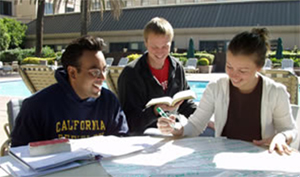 From left, Members of the Youth Worship Planning Committee for San Jose 2007 Ben Balonos, Jeremy Kempf and Kendra King work to plan worship for convention. The group last met October 26 through 28 in San Jose Ca. Photo by Marathana Prothro
From left, Members of the Youth Worship Planning Committee for San Jose 2007 Ben Balonos, Jeremy Kempf and Kendra King work to plan worship for convention. The group last met October 26 through 28 in San Jose Ca. Photo by Marathana Prothro

 William (Bill) Kull of West Point, PA was ordained to Christian ministry for the Methacton Mennonite Church on December 10, 2006, during a morning service at the church. Bill and his wife Susan have been members of Methacton Mennonite since 1987. Bill has been on the Pastoral Team at Methacton since July 2003, and before that was a lay leader in the congregation. Officiating and preaching at the service was Noah Kolb, Conference overseer for the Methacton Mennonite Church.
William (Bill) Kull of West Point, PA was ordained to Christian ministry for the Methacton Mennonite Church on December 10, 2006, during a morning service at the church. Bill and his wife Susan have been members of Methacton Mennonite since 1987. Bill has been on the Pastoral Team at Methacton since July 2003, and before that was a lay leader in the congregation. Officiating and preaching at the service was Noah Kolb, Conference overseer for the Methacton Mennonite Church.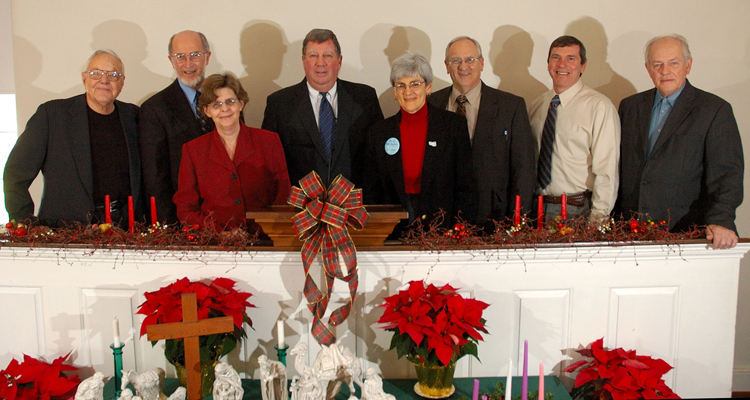

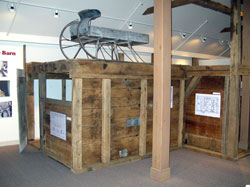 The Mennonite Heritage Center, 565 Yoder Road, Harleysville, announces a new exhibit As Large as Palaces: Pennsylvania German Barns. The exhibit focuses on the history, functions, and architecture of the beautiful nineteenth century Pennsylvania German barns in southeastern Pennsylvania. As Large as Palaces features a reconstruction of an original barn’s threshing floor and bents (or framing sections), along with a granary and a recreation of cow stable from the lower level of a barn. Vintage barn photographs and diagrams of barn architecture, as well as examples of 19th century farm tools and equipment show how barns were designed to house animals and provide for crop processing and storage. The exhibit will run until October 29, 2007.
The Mennonite Heritage Center, 565 Yoder Road, Harleysville, announces a new exhibit As Large as Palaces: Pennsylvania German Barns. The exhibit focuses on the history, functions, and architecture of the beautiful nineteenth century Pennsylvania German barns in southeastern Pennsylvania. As Large as Palaces features a reconstruction of an original barn’s threshing floor and bents (or framing sections), along with a granary and a recreation of cow stable from the lower level of a barn. Vintage barn photographs and diagrams of barn architecture, as well as examples of 19th century farm tools and equipment show how barns were designed to house animals and provide for crop processing and storage. The exhibit will run until October 29, 2007.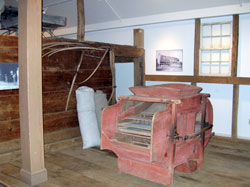 Farm life centered around the barn and family members spent many hours milking cows, feeding animals, assisting with calving, loading and unloading hay, and threshing grain. Throughout the eighteenth and nineteenth centuries, agriculture thrived, grew, and changed but the barn remained the hub of farm life. Increasing mechanization and sanitary standards brought more changes to farming in the twentieth century and barns were renovated to deal with the changing times. Stanchions and cement floors replaced wooden stables and earthen floors. Milking machines and farm machinery increased production and decreased some of the grueling hand labor but many people still have memories of going out to the barn to milk on an icy winter morning or of unloading hay in the heat of the summer.
Farm life centered around the barn and family members spent many hours milking cows, feeding animals, assisting with calving, loading and unloading hay, and threshing grain. Throughout the eighteenth and nineteenth centuries, agriculture thrived, grew, and changed but the barn remained the hub of farm life. Increasing mechanization and sanitary standards brought more changes to farming in the twentieth century and barns were renovated to deal with the changing times. Stanchions and cement floors replaced wooden stables and earthen floors. Milking machines and farm machinery increased production and decreased some of the grueling hand labor but many people still have memories of going out to the barn to milk on an icy winter morning or of unloading hay in the heat of the summer.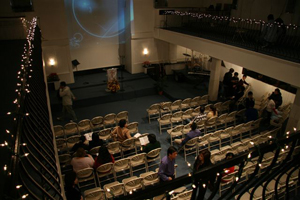 by Rachel Howe
by Rachel Howe 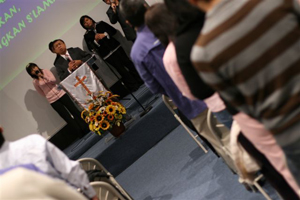 I am actually part of that prayer. I came to PPC in September of 2006 and immediately felt the presence of the Lord. The congregation welcomed me with open arms and has not let go. God’s passion is evident in everyone. It does not matter what language you speak. I have learned so much from sitting, listening and watching.
I am actually part of that prayer. I came to PPC in September of 2006 and immediately felt the presence of the Lord. The congregation welcomed me with open arms and has not let go. God’s passion is evident in everyone. It does not matter what language you speak. I have learned so much from sitting, listening and watching. On December 5 about 50 of us from the larger Souderton area traveled to Philadelphia for the annual Pastors’ Appreciation Breakfast. For several years the pastors from the Kingdom Builders, an association of Anabaptist churches in the city, have been invited to be part of this pre-Christmas event. A year ago it was agreed that in 2006 we would meet in the city. Our breakfast was hosted by the Philadelphia Mennonite High School.
On December 5 about 50 of us from the larger Souderton area traveled to Philadelphia for the annual Pastors’ Appreciation Breakfast. For several years the pastors from the Kingdom Builders, an association of Anabaptist churches in the city, have been invited to be part of this pre-Christmas event. A year ago it was agreed that in 2006 we would meet in the city. Our breakfast was hosted by the Philadelphia Mennonite High School. distant from the centers of church power (Elkhart/Harrisonburg/Newton). Again and again denominational leaders needed to be reminded that it is as far from Oregon to Indiana as it is from Indiana to Oregon. We seem to forget this simple truism when it comes to attending events outside our familiar environment. Why does it seem far for us in Harleysville to go to Philadelphia, while we assume those who live in the city should not mind traveling to meetings in Souderton?
distant from the centers of church power (Elkhart/Harrisonburg/Newton). Again and again denominational leaders needed to be reminded that it is as far from Oregon to Indiana as it is from Indiana to Oregon. We seem to forget this simple truism when it comes to attending events outside our familiar environment. Why does it seem far for us in Harleysville to go to Philadelphia, while we assume those who live in the city should not mind traveling to meetings in Souderton?